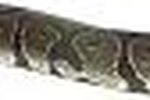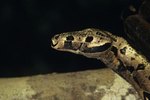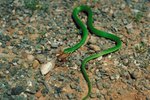
While zoos and professional snake breeders sometimes house snakes together, it is most appropriate to house pet snakes alone. Among other reasons, communally-housed snakes are subject to feeding accidents with grave consequences; snakes may injure, kill or consume a cage mate that grabs the same rodent that they do. If you must house multiple snakes together in a single cage, always separate them before feeding.
The Disappearing Snake
If you feed two snakes while they are in the same enclosure, it is possible that they will both grab the same rodent -- a problem you must avoid at all costs. If you and your snakes are lucky, one of the snakes will release the food item before anything bad happens. However, in a worst-case scenario, neither lets go, and the larger snake consumes the rodent and the smaller snake. While such encounters are invariably fatal for the smaller snake, the larger animal can become very sick from eating such an extraordinarily large meal. Usually, the snake will regurgitate the meal a day or two later, however others grow very ill and die. If one of your snakes eats a cagemate, do not disturb the animal any more than necessary and contact your veterinarian immediately.
Can't Stand the Stress
Even if the smaller animal eventually lets go of the rodent and avoids ingestion by the larger animal, he may not escape serious injury. The smaller snake may suffer broken bones and bruises from being constricted or it could have large puncture wounds or lacerations from the larger snake’s teeth. Stress often follows these traumatic events, potentially inhibiting immune function and causing long-term anorexia.
Proper Protocol
While it is best to feed snakes inside the cage in which they normally reside, if you house two snakes together, transfer one of them to a temporary cage before offering food to either animal. Besides preventing two snakes from grabbing the same rat, both snakes will likely exhibit better feeding responses when not distracted by the presence of another animal. Feed your snakes frozen-thawed rodents so that you have more control over the feeding process. Use a long pair of tongs or hemostats to hold the rodent in front of your snake.
The Royal Treatment
Snakes often exhibit elevated prey drives immediately following a meal, and may bite anything that moves, looks or smells like prey. To prevent overzealous snakes from eating their cage mates, keep your snakes in separate containers for at least one hour after feeding them. This is especially important with kingsnakes (Lampropeltis getula ssp.) and milk snakes (Lampropeltis triangulum ssp.), who are predisposed to eating other snakes.
References
Photo Credits
-
Jupiterimages/Photos.com/Getty Images



